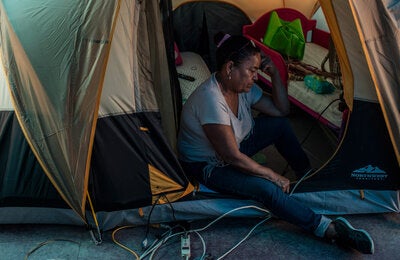

Studies in the Americas and around the world show that violence against women is alarmingly common. At least one out of every three women worldwide suffers violence at some point in her life. Less common ?but with potentially lifelong consequences? are violence and abuse that happen to girls during childhood.
Washington, D.C., 11 October 2013 (PAHO/WHO) — Studies in the Americas and around the world show that violence against women is alarmingly common. At least one out of every three women worldwide suffers violence at some point in her life. Less common ?but with potentially lifelong consequences? are violence and abuse that happen to girls during childhood.
"A girl born in the 21st century should face limitless possibilities for a productive and fulfilling life," said Alessandra Guedes, regional advisor on intra-family violence at PAHO/WHO. "Unfortunately, far too many girls are stifled by experiences of violence and abuse."
According to survey data from 12 countries in Latin America and the Caribbean compiled by the Pan American Health Organization/World Health Organization (PAHO/WHO) and the U.S. Centers for Disease Control (CDC), the proportion of women who report having been physically abused before the age of 15 ranged from 17% in Paraguay to around 31% in Guatemala and El Salvador and nearly 70% in Jamaica. The proportion of women who report having been sexually abused before age 15 was 3% in Ecuador and Paraguay, 4% in Nicaragua, and 6% in El Salvador.
Research also shows that girls who experience maltreatment in childhood or are exposed to violence against their mothers or stepmothers are at greater risk of becoming victims of intimate partner and sexual violence later in life. Studies have also linked violence against girls to a host of both physical and mental health problems, including broken bones, unwanted pregnancies and depression.
PAHO/WHO is working with its member countries to prevent violence, identify abuse early, ensure compassionate and appropriate treatment for survivors, using community-based approaches and working with sectors beyond health. This work includes support for the development of multisectoral approaches and integrated strategies to involve stakeholders from government and civil society in preventing violence against women and children at the local, national and regional levels.
A prime example of these efforts is Costa Rica's creation of a multisectoral working group that brings together professionals from various institutions that can play an active role in violence prevention. The group includes representatives of PAHO/WHO, the Ministry of Health, the Ministry of Public Education, the Costa Rican Social Security Fund and the National Institute of Women as well as participants from local government and civil society. Together, members develop comprehensive, multisectoral and sustainable violence prevention interventions based on the premise that "violence is generated and reproduced where socialization occurs — in families, schools and daycare centers, and communities — where people are together, learn and share." The ultimate goal is for all of these spaces to become safe environments where all forms of violence are rejected and gender equality, social harmony and a shared responsibility for ending violence are promoted.
"The health sector has a major role to play in violence prevention, but it cannot act alone," said Dr. Gina Tambini, director of the Family, Gender and Life Course department at PAHO/WHO. "Evidence shows that long-term prevention will require comprehensive, multisectoral approaches by both government and civil society. And this collaboration can result not just in violence prevention but in better lives for girls overall."



